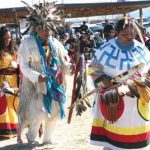Newcomers to the northwestern Arizona highlands are surprised by a smattering of snow that comes to interrupt the usual stifling dryness. Amid this dryness, dozens of Indian bands or scattered tribes are regrouped in reservations. The focus here is the Yavapai “people of the sun” who reside in Camp Verde, Clarkdale, and other locations belonging to the Yavapai-Apache Nation that has 2,300 members. History wanted the Yavapai to be regrouped with the Apache after so many Europeans descendants labeled them as such. They call themselves the “Wipuk’a’bah” though they may not have been forward with it since they were repeatedly confused or labeled for different tribes besides Apache such as the “high-pitched voice” people, and the “tonto-apache” (foolish apache, from Spanish, ed.). However, the Yavapai are of the Yuman family and fewer than one hundred fluently speak a distinct indigenous language (78-98% intelligible with Walapai and Havasupai, the closest relations).
From initial European contact in the 16th century to 1875 and the loss of vast ancestral homelands till modern times and the Cliff Castle Casino-Hotel bringing in gaming revenue, the Yavapai survived, migrating several times to conform with reservation assignments. They wore a variety of clothes to adapt to the extreme climates and to be called yet another name, “cruzados” (those with crosses, from Spanish, ed.). Their language survived too through stories of yesteryear, songs, and cultural activities. Academically, Alan Shaterian is responsible for a dictionary and phonology of Yavapai, Martha Kendall discusses grammar and syntax, and others such as James Redden have studied the Yuman family and purport an appurtenance to the larger Hokan family. Regardless, crucial elements of Yavapai are a case suffix (attached to nouns, verbs, and parts of speech alike if they are the last word of a noun phrase), quantifiers and some qualifiers having predicate force, and the word for “with” and “and” being identical.
Yavapai sentences are completely deconstructed in these work and the absence of vocabulary lists elsewhere is frustrating. Internet readers usually only find that “acorn” has about nine different words in Yavapai. Another Kendall publication: The Word for Old Woman in Northeastern Yavapai provides some hope with mention that woman is “qi” and women are “qoy”. An old woman is “qmwirma”. Interestingly, “wir” is also a verb meaning “to finish” signifying that after child-bearing age they would be “finished” or would have “completed” womanhood. Obviously the respect for the elderly remains high in these cultures. Kendall also discusses that the Yavapai used indigenous terms for post-Columbian exchange entries like “horse” or “cow” while Walapai and Havasupai borrowed from Spanish. This has changed with the new phenomenon of “yavaglish” that is now popular among the tribesmen.
The mixed usage of the language is already a triumph for the tribe that began a reservation school in Prescott, Yavapai county which only teaches middle-aged and older people. Inspiration from Havasupai with their school for all ages and widespread usage may be useful because elders sitting around a few tables is not encouraging for the future. They apparently compare notes on pronunciation, locations names, terms, etc. in between gossip. Their hero is Ted Vaughn who created interactive language software, recordings, and a phonetic writing of vocabulary for which he has won the “Spirit of the Heard” award and a proclamation signed by Jan Brewer. Retaining the language will ensure mitigation of the urban development and the effects of Indian boarding schools which have promoted English so vehemently. Once roaming over 20,000 square miles in Arizona the Yavapai must forge a strong identity to not be confused for apaches and fight the slow disappearance of their native language.




